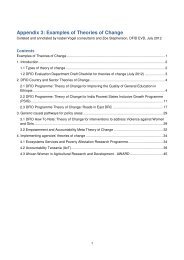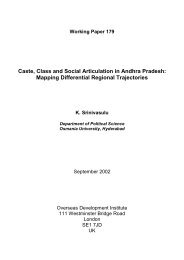Full Report - Research for Development - Department for ...
Full Report - Research for Development - Department for ...
Full Report - Research for Development - Department for ...
You also want an ePaper? Increase the reach of your titles
YUMPU automatically turns print PDFs into web optimized ePapers that Google loves.
HIV/AIDS and Malaria, as well as non-communicable diseases like diabetes or<br />
cardiovascular disease.<br />
Synthesis results<br />
When assessing whether studies met our inclusion criteria, not only did we want<br />
there<strong>for</strong>e to identify whether some studies looked at the costs of implementing<br />
interventions, but also whether we could identify any economic evaluations<br />
synthesising cost and effects data. In doing this we were interested not only in<br />
economic evaluations linked to empirical studies, but also those studies that<br />
constructed models drawing on effectiveness and resource use data from many<br />
sources to make a judgement on potential cost-effectiveness. The quality of<br />
evaluations included in our review was assessed using both the Drummond and<br />
Jefferson (1996) and Evers et al. (2005) checklists as recommended in the Cochrane<br />
Handbook <strong>for</strong> Systematic Reviews of Interventions (Higgins and Green, 2011).<br />
Results<br />
It is important to note that there is an ever-increasing evidence base looking at the<br />
cost-effectiveness of interventions related to maternal and infant health in low<br />
income country contexts (e.g. Jowett, 2000; Rouse, 2003; Adam et al., 2005; Vos et<br />
al., 2006; Darmstadt et al., 2008 (++)/(++); Goldie et al., 2010). For instance, Adam<br />
et al. (2005) drew together a range of data on the effectiveness of interventions to<br />
look at potential cost-effectiveness in sub-Saharan Africa and south-east Asia,<br />
coming to the conclusion that improving access to preventive measures and early<br />
care would all be cost effective in all settings. These would include antenatal care<br />
(tetanus toxoid, screening <strong>for</strong> pre-eclampsia, screening and treatment of<br />
asymptomatic bacteria and syphilis); skilled attendance at birth, offering first-level<br />
maternal and neonatal care around childbirth; and emergency obstetric and<br />
neonatal care.<br />
Despite this increase in the broad cost-effectiveness evidence base, our analysis<br />
suggests that few economic evaluations that explicitly met our inclusion criteria<br />
have been undertaken. Little work has been undertaken to look at issues of access,<br />
uptake and use of effective interventions in our study population. As part of our<br />
review, 11 potential economic evaluations were identified by the study team.<br />
However after reading the full text, only four met our inclusion criteria (Appendix<br />
4.8). Seven other studies were excluded because they did not have some focus on an<br />
urban poor population, although they did provide some further economic evidence<br />
<strong>for</strong> interventions to tackle maternal and infant mortality in low income country<br />
settings. For instance, Hounton et al. (2008) reported on the cost-effectiveness of<br />
improving access to skilled birthing care in a rural area of Burkina Faso. Meantime<br />
Hutton et al. (2009) reported that the administration of three sessions of<br />
sulfadoxine-pyrimethamine treatment to prevent malaria in infants up to the age of<br />
nine months in rural Tanzania and Mozambique had a cost per death averted of US<br />
$100 and US $300 respectively. Thus this intervention would be considered cost<br />
effective in these two populations. Tsu et al. (2009) suggested that increased use of<br />
oxytocin during the third stage of labour would be cost effective in reducing the risk<br />
of postpartum haemorrhage in rural Vietnam.<br />
From our original set of studies, we did identify some papers that had some limited<br />
in<strong>for</strong>mation on the costs of some services, but without any discussion of the<br />
consequences <strong>for</strong> health services and other resource use going <strong>for</strong>ward. We also<br />
identified several additional economic evaluations at the abstract screening stage<br />
that all focused on rural populations. For example, Rydzak (2008) and colleagues<br />
looked at the economic case <strong>for</strong> prenatal syphilis screening in sub-Saharan Africa as<br />
a whole, suggesting overall that some screening programmes could not only reduce<br />
stillbirths and infant deaths, but also reduce costs overall. Sutherland et al. (2009<br />
and 2010) modelled the potential cost-effectiveness of prenatal iron<br />
What are the effects of different models of delivery <strong>for</strong> improving maternal and infant health<br />
outcomes <strong>for</strong> poor people in urban areas in low income and lower middle income countries? 41









